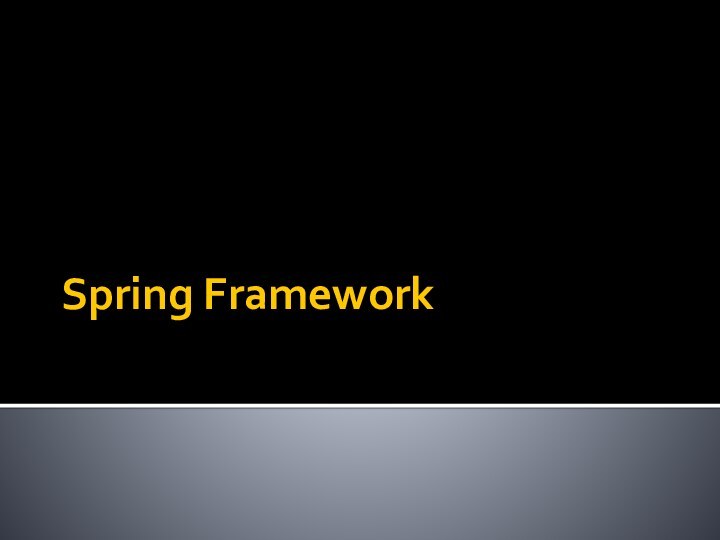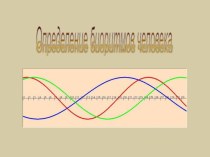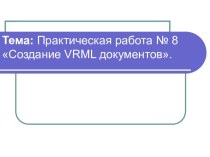Слайд 2
Spring Framework
http://www.springsource.com/
Слайд 3
Spring mission
J2EE should be easier to use
It's best
to program to interfaces, rather than classes. Spring reduces
the complexity cost of using interfaces to zero.
JavaBeans offer a great way of configuring applications.
OO design is more important than any implementation technology, such as J2EE.
Checked exceptions are overused in Java. A framework shouldn't force you to catch exceptions you're unlikely to be able to recover from.
Testability is essential, and a framework such as Spring should help make your code easier to test.
Слайд 4
Spring
Spring Framework is a Java platform that provides
comprehensive infrastructure support for developing Java applications. Spring handles
the infrastructure so you can focus on your application.
Spring enables you to build applications from “plain old Java objects” (POJOs) and to apply enterprise services non-invasively to POJOs. This capability applies to the Java SE programming model and to full and partial Java EE.
Слайд 6
Spring
Lightweight—Spring is lightweight in terms of both size

and overhead. The entire Spring framework can be distributed
in a single JAR file that weighs in at just over 1 MB. And the processing overhead required by Spring is negligible. What’s more, Spring is nonintrusive: objects in a Spring-enabled application typically have no dependencies on Spring specific classes.
Inversion of control—Spring promotes loose coupling through a technique known as inversion of control (IoC). When IoC is applied, objects are passively given their dependencies instead of creating or looking for dependent objects for themselves.
Aspect-oriented - Spring comes with rich support for aspect-oriented programming that enables cohesive development by separating application business logic from system services (such as auditing and transaction management). Application objects do what they’re supposed to do—perform business logic—and nothing more. They are not responsible for (or even aware of) other system concerns, such as logging or transactional support.
Container - Spring is a container in the sense that it contains and manages the life cycle and configuration of application objects. You can configure how your each of your beans should be created—either create one single instance of your bean or produce a new instance every time one is needed based on a configurable prototype—and how they should be associated with each other.
Framework - Spring makes it possible to configure and compose complex applications from simpler components. In Spring, application objects are composed declaratively, typically in an XML file. Spring also provides much infrastructure functionality (transaction management, persistence framework integration, etc.), leaving the development of application logic to you.
Слайд 7
Dependency injection
Inversion of Control (IoC)
“Hollywood Principle”
Don't call me,
I'll call you
“Container” resolves (injects) dependencies of components by
setting implementation object (push)
As opposed to component instantiating or Service Locator pattern where component locates implementation (pull)
Martin Fowler calls Dependency Injection
Слайд 8
Non-IoC / Dependency Injection
Слайд 9
Non-IoC Service Object
public class OrderServiceImpl implements IOrderService {
private
IOrderDAO orderDAO = new OrderDaoImpl();
public Order saveOrder(Order order) throws
OrderException{
try{
orderDao.saveOrder(order);
}catch(Exception e){
// handle e, rollback transaction, //cleanup, // throw e
}finally{
//Release resources and handle more exceptions
}
}
Слайд 11
IoC Service Object
public class OrderServiceImpl implements IOrderService {
private
IOrderDAO orderDAO ;
public OrderServiceImpl (IOrderDAO orderDAO) {
this.orderDAO = orderDAO;
}
public
void setOrderDAO (IOrderDAO orderDAO) {
this.orderDAO = orderDAO;
}
public Order saveOrder(Order order) throws OrderException{
try{
orderDao.saveOrder(order);
}catch(Exception e){
// handle e, rollback transaction, //cleanup, // throw e
}finally{
//Release resources and handle more exceptions
}
}
Слайд 12
Example. Printer
package org.lesson7.bean;
public interface IPrinter {
void printMessage();
void setMessage(String
valueOf);
}
package org.lesson7.bean;
public class Printer implements IPrinter {
private String message;
public
void setMessage(String message) {
this.message = message;
}
public void printMessage() {
System.out.println("Your Message : " + message);
}
}
Слайд 13
Example. Container
package org.lesson7.bean;
public class Container {
private IPrinter printer;
private
Double value;
public IPrinter getPrinter() {
return printer;
}
public void setPrinter(IPrinter printer)
{
this.printer = printer;
}
public void set(Double val) {
this.value = val;
}
public void print() {
printer.setMessage(String.valueOf(this.value));
printer.printMessage();
}
}
Слайд 14
Example. applicationContext.xml
class="org.lesson7.bean.Printer">
/>
Слайд 15
Example. Launcher
public class Launcher {
public static void main(String[]
args) {
ApplicationContext context = new ClassPathXmlApplicationContext(
new String[] {"beans.xml"});
Printer bean
= context.getBean("printer", Printer.class);
bean.printMessage();
Container container = context.getBean("container", Container.class);
container.set(1234d);
container.print();
System.out.println(bean == container.getPrinter());
}
}
Слайд 16
Example. Annotations (1)
Step 1:
@Service
public class Printer implements IPrinter
{ … }
@Service
public class Container { … }
Step 2.
@Service
public
class Container {
private IPrinter printer;
private Double value;
@Autowired
public void setPrinter(IPrinter printer) {
this.printer = printer;
}
Слайд 17
Example. Annotations (2)
public static void main(String[] args) {
ApplicationContext
context = new ClassPathXmlApplicationContext(
"beans-annot.xml");
Container container = context.getBean("container", Container.class);
container.set(1234d);
container.print();
}
Слайд 18
Annotations
@Component – common component
@Service - service classes
@Controller –
controller classes
@Repository – DAO classes
Слайд 19
@Required
This annotation simply indicates that the affected bean
property must be populated at configuration time: either through
an explicit property value in a bean definition or through autowiring. The container will throw an exception if the affected bean property has not been populated.
public class SimpleMovieLister {
private MovieFinder movieFinder;
@Required
public void setMovieFinder(MovieFinder movieFinder) {
this.movieFinder = movieFinder;
}
}
Слайд 20
@Autowired
1. Field
@Autowired
private IPrinter printer;
2. Constructor
@Autowired
public Container(IPrinter printer) {
this.printer
= printer;
}
3. Setter
@Autowired
public void setPrinter(IPrinter printer) {
this.printer = printer;
}
Слайд 21
@Autowired (2)
4. All beans of specific type
@Autowired
private IPrinter[]
printer;
5. Well-known "resolvable dependencies“
@Autowired
private ApplicationContext context;
Слайд 22
@Qualifier
Since autowiring by type may lead to multiple
candidates, it is often necessary to have more control
over the selection process. One way to accomplish this is with Spring's @Qualifier annotation.
@Autowired
@Qualifier("main")
private MovieCatalog movieCatalog;
@Autowired
public void prepare(@Qualifier("main") MovieCatalog movieCatalog,
CustomerPreferenceDao customerPreferenceDao) {
this.movieCatalog = movieCatalog;
this.customerPreferenceDao = customerPreferenceDao;
}
Слайд 23
JSR-250 Annotations
Spring also provides support for Java EE
5 Common Annotations (JSR-250). The supported annotations are:
@Resource
@PostConstruct
@PreDestroy
@Resource(name =
"dataSource")
public void createTemplate(DataSource dataSource) {
this.jdbcTemplate = new SimpleJdbcTemplate(dataSource);
}
public class CachingMovieLister {
@PostConstruct
public void populateMovieCache() {… }
@PreDestroy
public void clearMovieCache() {… }
}
Слайд 26
Spring AOP
Spring AOP (Aspect-oriented programming) framework is used
to modularize cross-cutting concerns in aspects.
Put it simple,
it’s just an interceptor to intercept some processes, for example, when a method is execute, Spring AOP can hijack the executing method, and add extra functionality before or after the method execution.
Слайд 27
Spring AOP
In Spring AOP, comes with three very
technical terms – Advice, Pointcut, Advisor:
Advice – Indicate the
action to take either before or after the method execution.
Pointcut – Indicate which method should be intercept, by method name or regular expression pattern.
Advisor – Group ‘Advice’ and ‘Pointcut’ into a single unit, and pass it to a proxy factory object.
Слайд 28
Spring AOP
In Spring AOP, 5 type of advices
are supported :
Before advice – Run before the method
execution
After returning advice – Run after the method returns a result
After throwing advice – Run after the method throws an exception
After (finally) advice – Run after normal or exceptional return
Around advice – Run around the method execution, combine all three advices above.
Слайд 29
Spring AOP
Beans.xml:
@Component
@Aspect
public class TraceLogger {
@Pointcut("execution(* org.lesson7.bean.*.print(..))")
public
void log() {
}
@Around("log()")
public Object profile(ProceedingJoinPoint pjp) throws Throwable {
MethodSignature
signature = (MethodSignature) pjp.getSignature();
Method method = signature.getMethod();
long start = System.currentTimeMillis();
System.out.println("Going to call the method: " + method.getName());
Object output = pjp.proceed();
System.out.println("Method execution completed.");
long elapsedTime = System.currentTimeMillis() - start;
System.out.println("Method execution time: " + elapsedTime
+ " milliseconds.");
return output;
}














![Spring Framework Example. Launcherpublic class Launcher { public static void main(String[] args) { ApplicationContext context =](/img/tmb/15/1405403/e2c56e151e440541ee2463d20946bcb9-720x.jpg)

![Spring Framework Example. Annotations (2)public static void main(String[] args) { ApplicationContext context = new ClassPathXmlApplicationContext(](/img/tmb/15/1405403/3acc03f86c7c2436a21f3048cdd2bc01-720x.jpg)



![Spring Framework @Autowired (2)4. All beans of specific type @Autowired private IPrinter[] printer;5. Well-known](/img/tmb/15/1405403/017269e697c9ad04ec54aff123533954-720x.jpg)






































